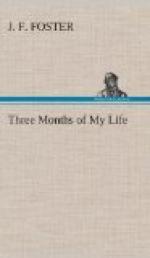July 16th.—Left Gingle with the earliest streak of dawn for Baramula, an eighteen mile march. Road very much more level, never ascending high above the river whose erratic course we continued to follow. Passed through groves of hazel overrun by wild vines, but both grapes and nuts as yet green. The plateaus become gradually larger and almost continuous, and the hills separated and diminished in size, those on the right being covered with the lank deodar, while those on the left possessed only a bright green mantle of grass, far away in front they altogether ended, and the open sky above the valley was alone visible. And now an unusual occurrence presented itself. We were following the stream upwards towards its source, yet at every mile it increased in width and became more placid, till at length its surface was unbroken, and it assumed the form of a magnificent river, wider than the Thames at Richmond. The hills continued provokingly to overlap one another as though anxious to shut in and hide the happy valley from sight. But at length I discerned a far distant white cloud which I guessed betokened the summit of a mountain, and a few yards further revealed a faint glistening opaque line which the inexperienced eye would have certainly taken for a portion of the cloud, but which could not be mistaken by one who had before seen the snows. About half a mile from Buramula we obtain the first view of the Vale of Kashmir, but not an extensive one, as it is obstructed on either side by low hills. However, what is seen is very pretty. A large level plain traversed by a broad smooth river which has now lost its tortuous zig-zag course and bounded by the everlasting snows covering the main backbone of the Himalayas. At the head of the valley stands the quaint looking town of Baramula surrounded by hills on all sides but one, embowered in trees and intersected by the Jhelum, across which there is a good wooden bridge. The houses have mostly an upper story, and are built of wood with gabled roofs. The streets are narrow and roughly paved, and I regret to say are not more pleasant to the nostrils than are those of other Indian towns. The bridge built of deodar wood, beams of which are driven into the bed of the river, and then others laid horizontally upon them, each row at right angles to and projecting beyond the layer beneath, till a sufficient height has been reached, six of these and two stone piers form the buttresses of the bridge and a broad pathway of planks connects them. The march was a fatiguing one on account of its length, and I used the dandy freely. I shall however discard it altogether for the future. I went to the Barahduree but found it occupied by a man whose name I was told was “——,” had been there five days. His Coolies had taken possession of all the rooms, and though I was very angry and inclined to turn them out, I thought my tent would be preferable to a room just vacated by the uncleanly native, so I went to an orchard close by, surrounded by a row




